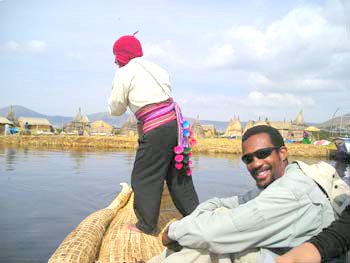Lake Titicaca, Peru (3/27/04 - 3/28/04)

YI Group in traditional attire, Isla Amantani, Peru

The most impressive islands were the floating islands of Uros. It is said that the people of Uros were Aymara and Quechua “Indians” who did not want to be dominated by the invading Incas. To escape domination they fled to Lake Titicaca and created islands by laying dead totora (reeds, somewhat like cattails) over growing totora that they bent to lay horizontal. The sinking feeling accompanied by the squish-squish sound you get while walking on the islands (most of which were about half the size of a football field) let’s you know that the island is indeed floating.

Floating Islands of Uros, Peru

What was most impressive is just how industrious these people are. Totora is incredibly abundant in Lake Titicaca. People of Uros use it for EVERYTHING! The fibrous roots are eaten as food and have medicinal functions which are good for the stomach, kidneys, and thyroid gland. The dried reeds not only serve as the ground and floor, but they are also bound to make the walls and roofs of all the houses. Bound in a different fashion they are made into boats which fishermen propel like boatmen in Italy propel gondolas in Venice.

Reed Boat, Lago Titicaca, Peru

Side note: Yes, I still think that Egyptians sailed their papyrus ships over here and taught indigenous people of the continent how to make their own boats eons before Columbus “discovered” “America”. (See Tiwanaku entry)


0 Comments:
Post a Comment
<< Home